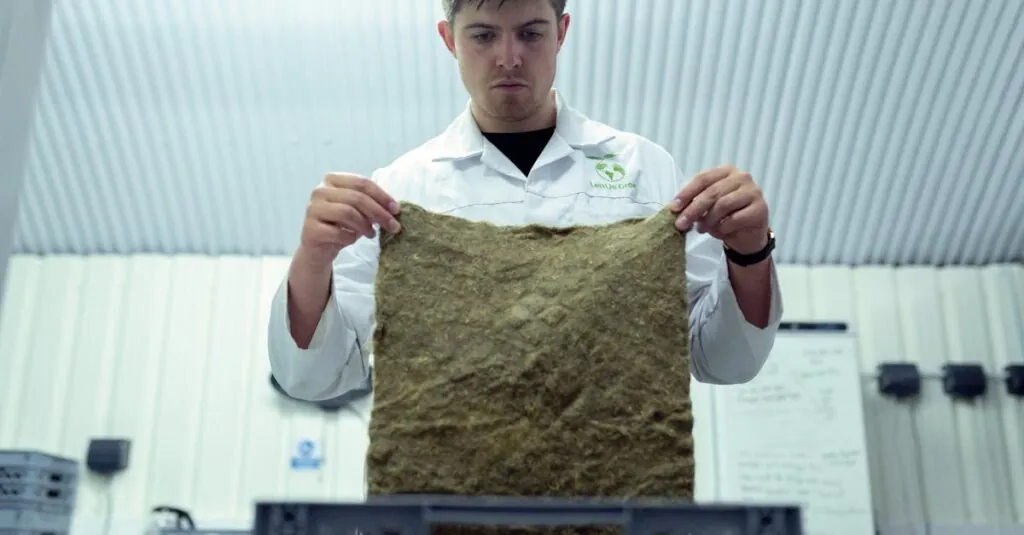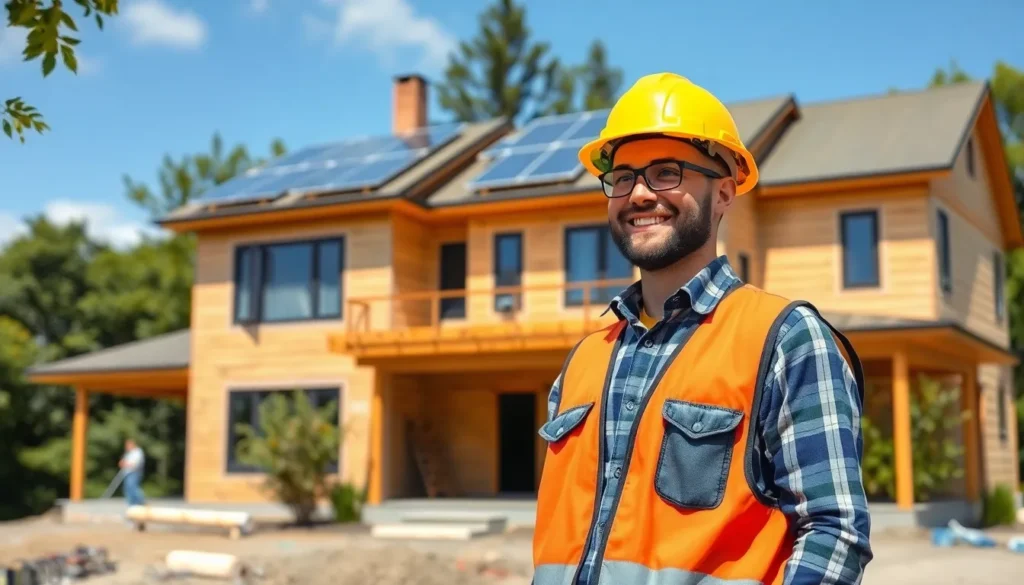Table of Contents
ToggleIn a world drowning in plastic, biodegradable alternatives are like a breath of fresh air—or perhaps a whiff of compost. These eco-friendly options are stepping up to the plate, ready to save the planet one shopping bag at a time. Who knew that saving the Earth could be as easy as swapping your regular plastic for a product that breaks down faster than a bad date?
Overview of Biodegradable Alternatives
Biodegradable alternatives play a crucial role in reducing plastic waste. These products decompose naturally, breaking down into non-toxic components within a specific timeframe. Various materials serve as viable alternatives, including plant-based plastics, paper, and natural fibers.
Plant-based plastics derive from renewable resources such as corn and sugarcane. These bioplastics often exhibit similar properties to traditional plastics but offer a more sustainable lifecycle. Paper products, on the other hand, utilize recyclable materials, making them an eco-friendly choice for packaging and single-use items.
Natural fibers like hemp and jute also contribute to the biodegradable landscape. Products made from these fibers are durable and compostable, serving as excellent alternatives for bags and textiles. Research indicates that opting for these biodegradable products can significantly reduce landfill contributions.
Numerous companies produce biodegradable options, demonstrating the growing market. Brands like Biopak and Eco-Products focus on providing sustainable items that cater to environmentally conscious consumers. Their innovations highlight how businesses can thrive while prioritizing ecological responsibility.
Moving toward biodegradable alternatives involves a conscious effort. By choosing these eco-friendly products, individuals and businesses can contribute to a cleaner environment. Adopting biodegradable solutions not only aids waste reduction but also promotes a sustainable lifestyle that benefits future generations.
Types of Biodegradable Alternatives
Biodegradable alternatives play a crucial role in reducing landfill waste and minimizing environmental impact. Various materials provide effective solutions for sustainable living.
Plant-Based Materials
Plant-based materials include bioplastics made from renewable resources like corn and sugarcane. They offer a sustainable lifecycle that mirrors traditional plastics while being more environmentally friendly. These products decompose under industrial composting conditions, leaving no harmful residues. As an example, polylactic acid (PLA) is a popular material derived from cornstarch that serves as a viable option for various applications, from packaging to disposable cutlery. By embracing plant-based materials, consumers can support industries focused on sustainability.
Compostable Plastics
Compostable plastics present another innovative solution for reducing plastic waste. These materials break down in composting environments within a specific timeframe, typically 90 to 180 days. Usually, they consist of biomaterials or blends designed to decompose into organic matter, enriching soil and minimizing landfill impact. Products like compostable bags and food containers are common examples, often labeled to distinguish them from traditional plastics. Choosing compostable plastics encourages responsible disposal practices and fosters a circular economy.
Natural Fibers
Natural fibers, such as hemp, jute, and cotton, contribute sustainable alternatives for various products. These materials offer durability and compostability for applications including bags, textiles, and packaging. Natural fibers, unlike synthetic options, biodegrade easily, returning to the ecosystem without harmful side effects. As a point of reference, jute grows quickly and requires fewer resources, making it an eco-friendly choice. Opting for products made from natural fibers supports sustainable agriculture and reduces dependence on plastic.
Benefits of Biodegradable Alternatives
Biodegradable alternatives provide essential benefits for both the environment and the economy. The transition to these eco-friendly products can foster significant positive changes.
Environmental Impact
Reducing plastic waste is a primary benefit of biodegradable alternatives. These products decompose into non-toxic substances within a specific timeframe, which helps mitigate pollution. Plant-based materials such as polylactic acid (PLA) and compostable plastics enrich soil as they break down, minimizing landfill contributions. Furthermore, natural fibers like hemp and jute decompose naturally, reinforcing sustainable agricultural practices. The adoption of these products significantly decreases the toxic burden on ecosystems, promoting cleaner air and water sources.
Economic Advantages
Choosing biodegradable alternatives also presents compelling economic benefits. The expanding market for these products creates job opportunities across various sectors. Businesses investing in biodegradable solutions often enhance their brand image, attracting environmentally conscious consumers. Cost savings emerge from reducing waste management expenses associated with traditional plastics. Additionally, companies involved in the production of biodegradable items can tap into growing sustainability trends, increasing their competitive advantage. Overall, supporting biodegradable alternatives contributes to a sustainable economy, fostering long-term growth and stability.
Challenges in Adoption
Challenges exist in the widespread adoption of biodegradable alternatives. These hurdles range from technological limitations to consumer awareness issues.
Technological Limitations
Technological limitations hinder the effective production and use of biodegradable products. Current manufacturing processes often lack efficiency, which affects the scalability of these alternatives. In some cases, biodegradable materials decompose only under specific conditions, like industrial composting, and this restricts their use in diverse environments. Moreover, product performance can vary, leading to concerns about durability and functionality compared to traditional plastics. Notably, advancements in bioplastics are necessary to create more versatile solutions. Research and development in the industry aim to address these challenges and improve the viability of biodegradable materials.
Consumer Awareness
Consumer awareness remains a significant challenge for promoting biodegradable alternatives. Many consumers lack knowledge about the benefits and uses of these products. Misconceptions surrounding biodegradability, including confusion over disposal methods, exacerbate the issue. Educational campaigns can help clarify misconceptions and highlight the positive impacts of choosing biodegradable options. Marketing strategies also play a vital role in informing consumers, making it essential for companies to communicate effectively. Increasing awareness will encourage more individuals to consider sustainable choices, fostering a shift toward eco-friendly practices.
Future Trends in Biodegradable Alternatives
Innovation drives the development of biodegradable alternatives, pushing industries to adopt sustainable practices. Emerging technologies focus on enhancing the efficiency of biodegradable materials, making them more practical for widespread use. Companies invest in research to create bioplastics that decompose effectively in various environments, thereby addressing durability concerns.
Consumer preferences continue to evolve, increasing demand for eco-friendly products. A rise in awareness about environmental impact influences purchasing decisions, pushing brands to invest in biodegradable packaging. Trends show an uptick in consumer interest in plant-based plastics, compostable materials, and natural fibers as sustainable choices.
Collaboration between manufacturers and researchers fosters advancement in biodegradable alternatives. Such partnerships propel the discovery of new materials with enhanced properties, improving performance while maintaining eco-friendliness. Process improvements in manufacturing boost accessibility, allowing more products to enter the market.
Education plays an essential role in the adoption of biodegradable solutions. Initiatives aimed at informing consumers about the benefits and proper disposal techniques counter misconceptions that hinder acceptance. Retailers and brands benefit from impactful marketing strategies designed to highlight sustainability, contributing to overall consumer education.
Regulatory frameworks also evolve, supporting the transition to biodegradable alternatives. Governments worldwide are implementing policies that encourage environmentally friendly practices. These regulations stimulate investment in biodegradable technologies, thereby increasing the availability of sustainable products.
Increased collaboration, consumer awareness, education, and regulatory support shape the future of biodegradable alternatives. Trends indicate a stronger commitment to sustainability stemming from both consumers and businesses alike. These alignments promote the growth of an eco-conscious market dedicated to reducing plastic waste and fostering environmental health.
Embracing biodegradable alternatives is essential for a sustainable future. These eco-friendly products not only reduce plastic waste but also contribute to healthier ecosystems. By choosing materials that decompose naturally, individuals and businesses can play a crucial role in mitigating pollution and promoting environmental well-being.
As the market for biodegradable options continues to grow, awareness and education become vital. Understanding the benefits and proper disposal methods of these products can empower consumers to make informed choices.
The ongoing advancements in technology and innovation further enhance the practicality of biodegradable materials. With a collective commitment to sustainability, society can pave the way for a cleaner planet, ensuring a better world for future generations.







